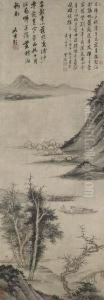Mo Shilong Paintings
Mo Shilong, born in 1539 and passing in 1587, was a prominent figure in the world of Chinese painting during the Ming Dynasty. His life and career encapsulate the rich tapestry of Chinese art during a period marked by both cultural flourishing and socio-political turmoil. Mo Shilong's contributions to the art world are particularly noted for their innovative approach to traditional Chinese landscape painting, as well as his mastery in the depiction of flowers and birds, which were popular subjects in the Ming period.
Mo Shilong's early life was steeped in the scholarly tradition of the time, which emphasized the importance of the arts in the cultivation of personal virtue and the expression of moral values. He was born into a family with a strong appreciation for art and literature, which undoubtedly influenced his career path. Despite the scarcity of detailed biographical information, records show that Mo Shilong was deeply engaged with the intellectual and artistic circles of his time, which played a crucial role in the development of his unique artistic style.
Throughout his career, Mo Shilong was known for his delicate brushwork and innovative use of color, which set his work apart from that of his contemporaries. His landscapes are often celebrated for their ethereal quality and the sense of harmony and tranquility they evoke. This was in line with the Daoist and Confucian philosophies that deeply influenced Chinese art and culture, emphasizing the unity of humanity and nature. Mo Shilong's ability to convey profound philosophical concepts through his art has cemented his legacy as one of the Ming Dynasty's most important painters.
Unfortunately, Mo Shilong's life and career were cut short when he died at the relatively young age of 48 in 1587. Despite his premature death, his influence on the development of Chinese landscape painting has been long-lasting. His works continue to be studied and admired for their contribution to the evolution of Chinese art, serving as a bridge between the classical traditions of the past and the innovations that would come in later periods. Mo Shilong's legacy is a testament to the enduring significance of art in expressing the depth and complexity of human experience and the natural world.

